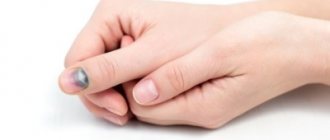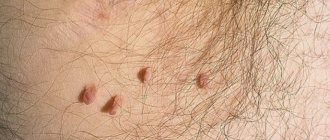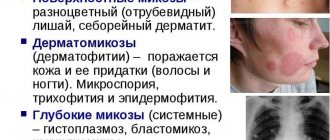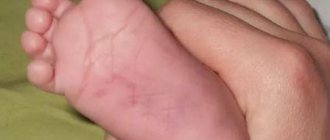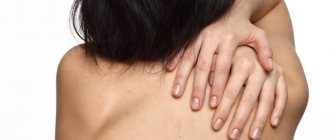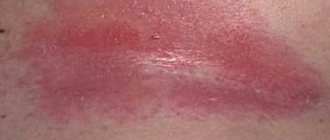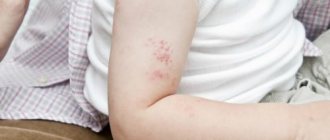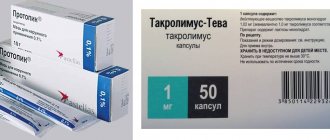( 1 ratings, average: 5.00 out of 5)
Home » Problems 18+
Mycosis in the groin area is the scourge of our time. It would seem that with the current level of medicine, an ordinary fungus can be cured - but without any problems. But the intimacy of the problem forces many to treat themselves, thereby only causing harm. The article will discuss the main nuances of the disease and its treatment.
Mycosis of the groin area: sources of infection
Transmission of infection occurs in one of the ways available to fungi:
- Sexual intercourse with a carrier.
- Using someone else's intimate hygiene products (towels, underwear).
- Visiting a public shower, sauna or swimming pool.
But the fact of transmission itself is not enough; in order for the disease to develop, the presence of some concomitant factor is necessary:
- Weakening of immune defense by long-term use of medications, especially antibiotics.
- Depleted immunity due to chronic or acute diseases.
- Frequent drinking or smoking.
- Systematic violation of personal hygiene standards.
- Eating disorders, consumption of low-quality foods.
- Excess weight associated with increased sweating.
- Incorrectly selected clothing (synthetic or tight underwear).
Simply following the rules of maintaining intimate hygiene, taking care of your body and visiting public places that control the cleanliness of swimming pools or shower rooms will significantly reduce the risk of infection with mycosis.
Prevention of lichen in the groin
To prevent infection with a dermatological disease in the groin area of the body, it is necessary to carry out a number of preventive measures:
Strengthen the immune system year-round, as well as timely treatment of other diseases. Try to eat a varied and balanced diet. Include physical exercise in your daily routine, eliminate or minimize the consumption of alcoholic beverages and quit smoking. Do not overeat or abuse diets. Observe precautions in public places, use only individual personal hygiene products, and do not wear other people’s clothes and shoes. When choosing clothes, give preference only to natural fabrics. Avoid hypothermia in the cold season and overheating in hot weather.
Pityriasis rosea in the groin is considered an infectious-allergic disease. Its causative agent is considered to be herpes type 7. With this disease, round spots with clear boundaries appear on the body.
Ringworm usually appears on the back, chest, limbs, and groin area. The disease occurs between the ages of 20 and 40 and affects men more often than women. This is due to increased sweating in the groin in males.
Features of the development of fungus on the skin in the groin area
Fungal skin infections in the groin are a fairly common problem. Judging by the statistics of medical institutions, this pathology is the third most common among fungal infections. In men, it develops approximately 3 times more often than in the fairer sex.
The disease develops according to the same pattern, regardless of what part of the skin it affects (groin, feet, axillary areas). In the absence of timely treatment, the infection will spread to nearby areas of the skin, and the manifestations will take on a pustular form.
Diaper rash in the groin in men: where to go?
When the first signs of diaper rash appear, you do not need to see a doctor right away.
Just keep your groin area dry.
The problem will go away the next day.
But in some situations, a doctor’s help is necessary.
It is needed in the following cases:
- erosion appeared;
- after 1-2 days, diaper rash does not go away, and there is no positive dynamics;
- plaques with an unpleasant odor appeared;
- severe pain or burning is felt;
- you see blisters, ulcers and other morphological elements in the groin;
- body temperature increased.
Then the help of a doctor is necessary.
Diaper rash can lead to complications.
You should not allow deep ulcers to appear, which will have to be treated surgically.
It is better to consult a doctor in a timely manner and undergo a course of conservative therapy.
You can contact our clinic.
Experienced dermatovenerologists work here who can quickly understand the problem and solve it.
If diaper rash appears in the groin, contact the author of this article, a dermatovenerologist in Moscow with many years of experience.
Diagnostics: scraping and Voodoo lamp
The examination to confirm the diagnosis and determine the causative agent of mycosis in a man and a woman differs depending on which doctor the patient consulted.
Among women
Dermatologists in tandem with a gynecologist carry out studies and their interpretation on the fair half of the population. The specialist may prescribe:
- Taking a scraping. This procedure involves collecting material from the affected area of skin to further determine the species of the pathogen.
- Wood's lamp examination. This device helps to conduct an examination without collecting material. By shining the light on the affected skin, the doctor can watch the area turn red, indicating athlete's foot.
- Bacteriological analysis. Sowing of microflora on nutrient media is carried out after taking a sample from the patient. It helps to examine the obtained material under a microscope to determine in the future what drugs are needed to treat a certain type of fungus.
- PCR or polymerase chain reaction. The technique is aimed at studying the DNA structure of the pathogen, which will make it possible to determine its type and resistance to certain antibiotics.
In men
Examination and further treatment of men with groin mycosis are carried out by dermatologists and urologists. Otherwise, all diagnostic measures are the same as for women.
Causes
Inguinal epidermophytosis (the so-called disease of the skin in the intimate area) causes a lot of inconvenience. Sometimes people themselves are to blame for the development of pathology; there are cases when it is difficult to influence the spread of the process.
Provoking factors:
- living in countries with a hot, humid climate;
- regular relaxation in baths, saunas, swimming pools;
- poor hygiene of intimate areas, wearing stale underwear;
- the use of other people's hygiene items when exercising in sports complexes and gyms.
Risk categories:
- patients with endocrine and cardiovascular pathologies;
- persons suffering from diabetes, obesity, metabolic disorders;
- patients with mycosis of the feet;
- people who experience stressful situations for a long time;
- persons with excessive sweating;
- people who, due to their profession, are forced to sit in one position for a long time (drivers of vehicles, train drivers, diesel locomotives, crane operators and others).
Note! Fungus in the groin develops more often in men than in women
Stages of inguinal mycosis
The course of mycosis in the groin occurs in 2 stages and each of them has its own differences, then a chronic focus of infection develops and in the end the disease takes on an advanced form.
initial stage
The beginning is also called the basic stage, during which the fungal mycelium enters the layers of the epidermis and further active reproduction of the pathogen occurs. All this is accompanied by the appearance of the first symptoms - spots with a clear boundary. Bubbles with liquid inside may appear along the edge of this border.
Second stage
The second stage is considered acute, since the fungal colony develops rapidly. The watery rash around the spots opens up, and the weeping space gradually increases. The inflammation spot itself decreases slightly, but the itching and irritation become much stronger.
Chronic stage
The transition of an infection to a chronic form is associated with its prolonged course without any therapeutic measures. The reddish heels persist, and relapses of inflammation occur, which is associated with increased moisture in the groin area due to sweating. Most often, relapse is associated with stressful situations.
Launched form
Refusal of treatment or failure to comply with doctor’s instructions leads to the fact that mycosis becomes advanced. Large watery blisters form, which, if damaged, become a source of secondary infection. The itching and burning intensify, and the spots darken at the edges.
Delaying treatment and the progression of the disease to an advanced form necessitates opening the blisters and treating the opened wound surface. The course of treatment becomes longer and more uncomfortable than therapy in the early stages.
Signs and symptoms of athlete's foot
With inguinal epidermophytosis, the inguinal folds are most often affected, less often the intergluteal folds, folds in the lower abdomen and under the mammary glands.
Initially, pinkish-reddish spots appear on the skin, slightly flaky and itchy. Along the edge, the lesion is surrounded by a continuous ridge slightly rising above the skin level. Over time, the spots merge and the affected area extends beyond the skin folds. The boundaries are sharp and clear. The outline is polycyclic.
With irrational therapy or injury, the surface becomes deep red, swollen, with many small blisters and cracks, pustules and purulent crusts. As mycosis progresses, inflammation spreads to the skin of the thighs, perineum, scrotum, buttocks and pubis. The disease is accompanied by severe itching. When the infection is transmitted to the hands, the armpits, folds under the mammary glands, the area of the elbows and popliteal fossae are affected. With a severe allergic reaction to Epidermophyton floccosum antigens, papules and vesicles appear, and with the addition of a bacterial infection, vesicles appear, which turn into pustules (vesicles with pus).
If there are a lot of bubbles, wetting occurs and areas of erosion (damage) appear. Subjectively, patients are bothered by itching from moderate to very strong, painful. Resolution of inflammation occurs from the center. The skin turns pale, acquires a brown color, pigmentation and gentle peeling appear. Along the periphery, a red-pink edematous ridge remains, dotted with small bubbles, scales and crusts.
Due to the similarity of foci of inflammation with eczema, the disease was in the past called “fringed eczema” (eczema marginatum). Inguinal epidermophytosis is characterized by a long (months and years) course with frequent relapses, especially in the hot season.
Rice. 5. Inguinal athlete's foot in a man. Foci of mycosis spread to the skin of the thighs.
Rice. 6. Inguinal athlete's foot in men.
Treatment of inguinal mycosis
The basis of therapy for inguinal mycosis is medications of various types, which, if the patient wishes, can be supplemented with some folk remedies.
Medication part of recovery
Medicines in the doctor’s arsenal include:
- Ointments with antifungal action: Pimafucin, Miconazole, Clotrimazole.
- Antifungal agents in tablet form or capsules: Fucis, Griseofulvin, Ketoconazole.
- Antiseptics: Sulfur ointment, Fukarcin, salicylic acid.
- Antihistamines: Suprastin, Fenkarol, Zyrtec. Their goal is to relieve itching.
In addition to this there are various immunomodulators, biological supplements and vitamin complexes.
Current folk methods
The following proven traditional medicines are most often used:
- Herbal infusion. It includes: dried violet, chamomile, lingonberry leaves, St. John's wort, yarrow and eucalyptus. All these plants in the amount of 100 g are crushed and poured with a liter of boiling water, and allowed to brew for 12 hours. Then filter and drink 50 g 3 times a day.
- Lotion. It includes string, flax seeds, yarrow and oak bark. All plants are taken dry and mixed in equal proportions. They are poured with 1 liter of boiling water and allowed to stand for a day. After filtering, cotton pads are soaked in the infusion and applied to the affected skin. After the lotion, these same places are wiped with zinc ointment.
- Ordinary celandine. This plant is crushed and simply applied to the blemished skin for 30 minutes.
Any traditional medicine recipe should not be used by the patient without the consent of a specialist, since there is a high probability that it will aggravate the situation and complicate therapy.
Ringworm on the labia
Not only men, but also women are susceptible to shingles; in the latter, painful spots appear on the labia and perineum, and a photo will help identify the disease, but patients cannot do without qualified medical care. Intolerable itching and burning occur in the genital area, which means the onset of an inflammatory process.
In advanced stages, the light affected areas will darken and blisters with suppuration will appear on them. In addition, in the fair sex, the disease will spread to other parts of the body, including the legs and anus. In the absence of proper treatment, lichen will lead to disruptions in the functioning of the entire body.
Specifics of laundry disinfection
In order to destroy the fungus, it is necessary to disinfect the patient’s underwear.
To do this, boil it for 15-20 minutes in a 2% solution of soap and soda. Then iron it with a hot iron. Tights are subjected to the same procedure if they have been used by a person since the onset of the disease. Mycosis affecting the groin area is not a death sentence. The disease has a favorable prognosis, even in advanced cases. The medications available to medical staff show good and quick results, which guarantees patients a return to their normal lifestyle without unpleasant discomfort and itching.
Ringworm on penis
In men, signs of lichen occur in addition to the lower abdomen, on the scrotum and head of the penis, as well as on the inner thigh and folds of the buttocks, which indicates the need to contact the dermatology department for adequate treatment (for clarity, you can see the photo on the medical website). Patients experience severe itching and cannot get rid of it with a shower. The skin affected by the disease becomes severely inflamed, blisters and peeling appear.
When the genital organs are affected, patients complain of pain when urinating, as well as the appearance of round spots on the dermis, outlined by narrow inflamed areas. To avoid complications of a fungal infection, it is forbidden to scratch the groin area.
The initial stage is characterized by isolated pink areas affected by the fungus. In severe cases, the spots darken, pustules appear, and then the rashes merge into one large spot.
At the beginning of the disease, men notice a slight itching in the groin area and genitals, which intensifies over time. Then itching sensations appear in the anus and rashes appear on the affected areas. If you do not start treating the disease in time, pathogenic microorganisms invade the healthy surface of the epidermis.
Symptoms of pathology
The most important symptom of this pathology is itching in the area of the genital organs and peri-inguinal area. Over time, this symptom becomes more painful and then becomes permanent. In the male half, itching occurs on the thighs, in the groin, while it bypasses the penis.
Over time, a red or brown rash forms. The border of the infected area can be determined by the presence of looped figures. Next, small blisters may appear on the rash, containing liquid inside. The skin begins to peel off, forming small cracks. Areas that border the affected skin become red and may also peel.
Factors of infection
Since moisture is a favorable condition for the growth of fungal bacteria, infection occurs in conditions of high humidity, for example, with frequent visits to public baths, saunas, and swimming pools. Women who do not follow basic rules of personal hygiene are at risk of becoming infected.
There is also a risk of acquiring this disease if:
- presence of diaper rash on the body;
- high sweating;
- reduced immunity;
- a sharp change in climate to humid and warm.
Visually, the disease manifests itself directly in the genital area, on the buttocks and inner thighs in the form of redness and peeling of the skin, reminiscent of a burn.
How to treat?
Drug treatment
Miconazole ointment is used for topical use.
If the fungal infection in the inguinal folds is not advanced and the disease develops at the initial stage, then topical medications, such as antifungal creams, ointments, gels, and sprays, are suitable for treatment. Ointments such as Miconazole, Terbinafine, Clotrimazole, Mikozolin, and Triderm have proven themselves well. Use the products only according to the scheme suggested by the doctor; self-prescription of drugs is prohibited. In addition to external treatment of lichen lesions, antihistamines are prescribed for severe itching and discomfort. These are “Diazolin”, “Suprastin”, “Pipolfen”, “Diphenhydramine”.
In women and men, treatment for inguinal fungus is almost identical. If the fungus is localized in a woman’s intimate area, it is worth visiting a gynecologist who will help rule out other diseases with similar symptoms and prescribe appropriate treatment. In addition to drug therapy, it is important to maintain personal hygiene of the inguinal folds to speed up recovery.
Ringworm in the groin in men is a rather unpleasant pathology caused by a fungal infection. The affected intimate area not only does not look aesthetically pleasing, reducing social and sexual activity, but also causes a lot of inconvenience to a person. The clinical signs of lichen are similar to other diseases of bacterial and viral origin, and allergic diseases. Timely diagnosis and establishment of the true cause of the appearance of a pathological process on the skin of the groin area contributes to effective treatment and prevention of relapses.
Ringworm in the groin area is often diagnosed under the medical term athlete's foot. This feature is explained by the fact that microsporum and trichophyton fungi most often cause this disease. Ringworm on intimate places is also caused by yeast fungi of the genus Candida and some types of viruses. Along with rashes in the genital area, the inflammatory process in this case spreads to other parts of the body. To determine treatment tactics, it is necessary to carry out a set of diagnostic measures aimed at searching for the pathogen and determining its resistance.
The set of diagnostic measures includes the following procedures:
- Visual examination of the affected area by a dermatologist. For help, you can contact a dermatologist, dermatovenerologist, infectious disease specialist, or endocrinologist. If there are concomitant diseases, consultation with other specialists is required.
- The use of a Wood's lamp is an important point in diagnosis. It allows the doctor to verify the suspected diagnosis. The highlighted elements of the rash acquire a yellow-green or yellowish-red color depending on the type of pathogen.
- In some cases, dermatologists use an iodine test. If foci of inflammation stained with iodine after wiping them with alcohol retain a brown color and loose structure, then the likelihood of lichen is high.
- Scrapings from the affected areas (scales, crusts) are sent to the laboratory for further testing on the nutrient medium. This procedure is a defining moment in diagnosis. The test results contain important information for the doctor, on the basis of which he prescribes further treatment.
- A blood test (including hormone tests) allows you to assess the general condition of the body and the extent of the damage.
- If any other pathologies are suspected, the dermatologist will refer you for additional examination to other specialists: endocrinologist, gastroenterologist, urologist, proctologist, psychotherapist.
Any rash in the groin is a signal for a man to seek qualified help from a medical facility. Due to the fact that foci of inflammation are concentrated in intimate places, many prefer to hide this problem from prying eyes. Self-medication threatens the development of complications and the disease becoming chronic. Lack of information about the dangers of fungal infection provokes some patients to self-prescribe antifungal drugs.
Clinical symptoms of lichen are often similar to other diseases, which complicates diagnosis without the use of laboratory and instrumental research methods.
Such manifestations are similar to diseases such as:
- allergic dermatosis;
- candidiasis;
- systemic lupus;
- syphilitic roseola.
In most cases, this pathology is presented in the form of rashes ranging from pink to brownish. Round spots are surrounded by a halo of more saturated color. The halo of spots looks like nodular rashes or pustules. The lesions are prone to peeling. Merging, they form a continuous wound surface.
Triderm
This medication effectively relieves inflammation, fungal infections and has an antibacterial effect.
The main active ingredients include:
- clotrimazole;
- gentamicin;
- betamethasone dipropionate.
The consistency of the ointment is homogeneous, it is white in color, without foreign inclusions. The drug is used in the treatment of various dermatological pathologies, which include inguinal dermatophytosis. But you cannot use Triderm for:
- hyperactivity to various components;
- open wounds;
- dermal tuberculosis;
- patients under 2 years of age.
During pregnancy, use the ointment with caution. During lactation such treatment is unacceptable. Side effects include:
- burning, itching;
- violation of dermal pigmentation;
- redness;
- peeling;
- swelling of the skin;
- hives
The drug should be applied to the affected area in the morning and evening. With regular use, a lasting therapeutic effect is guaranteed. Positive dynamics can be seen after 3-4 weeks.
Exoderil
This ointment is actively used in the treatment of fungus on the feet, nails and skin between the legs in the groin. It is an antifungal agent, intended for external use. Used in the treatment of fungal infections caused by dermatophyte fungi. The active component of Exoderil is naftifine.
Apply the cream in a small amount to the affected area. Apply the product using massaging movements and wait for it to be absorbed. It is necessary to apply the product before going to bed. The duration of treatment is determined by the doctor taking into account the severity of the pathological process.
